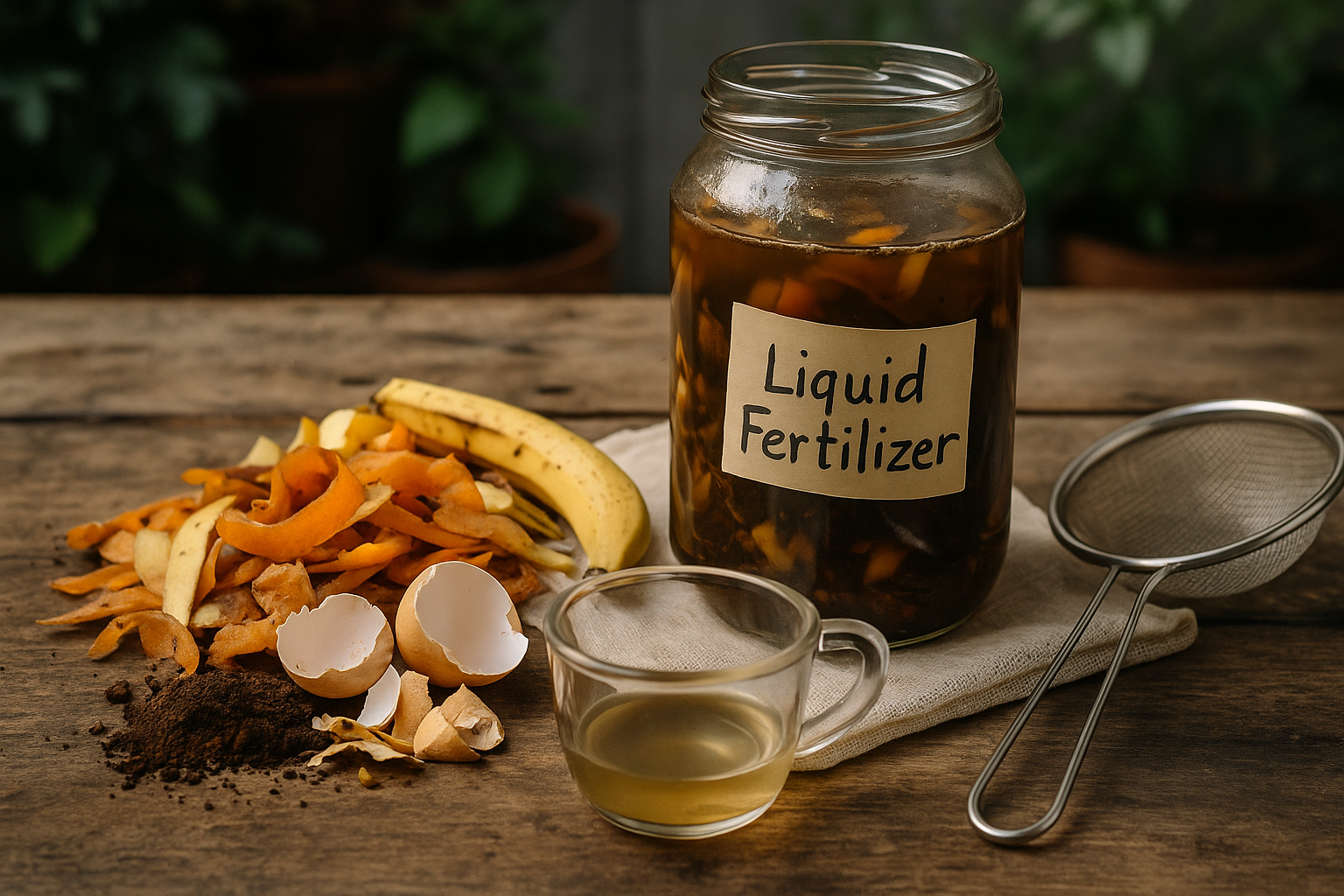Feeding your plants doesn’t have to cost money — in fact, some of the best fertilizers are hiding in your kitchen waste. Liquid fertilizer made from food scraps is not only effective and natural, but it also helps reduce household waste and support a more sustainable lifestyle. In this article, you’ll learn how to make homemade liquid fertilizer using common food scraps, how to apply it, and which plants benefit the most from this eco-friendly solution.
Why Choose Liquid Fertilizer?
Liquid fertilizers are especially useful for:
- Quick nutrient absorption
- Easy application (through watering)
- Immediate boost to plant health
- Supporting soil microbe activity
Homemade versions can be just as effective as commercial products — without the cost or chemicals.
What Food Scraps Work Best?
Not all kitchen waste is good for your plants. Here are some of the most effective and safe scraps for liquid fertilizer:
- Banana peels: Rich in potassium and phosphorus — great for flowering plants.
- Vegetable peels: Carrot, potato, cucumber, and others provide trace minerals.
- Coffee grounds: High in nitrogen — ideal for leafy greens and acid-loving plants.
- Used tea bags: Adds tannins and nutrients to the soil.
- Eggshells: Packed with calcium — perfect for tomatoes and peppers.
- Rice water: Contains starches that feed beneficial soil bacteria.
Avoid meat, dairy, and oily foods — these can spoil and attract pests.
How to Make Basic Liquid Fertilizer (Soaking Method)
This method is the simplest and requires only food scraps, water, and a container.
You’ll need:
- 1 jar or bucket with a lid
- Chopped food scraps (preferably a mix)
- Water (tap water is fine, rainwater is better)
- A strainer or cheesecloth
Steps:
- Fill the container 1/3 with scraps.
- Add water to cover the scraps completely.
- Let it sit for 3–7 days (keep the lid slightly open).
- Stir daily to speed up nutrient extraction.
- After steeping, strain the liquid into another container.
- Dilute it (1 part fertilizer to 5 parts water) before applying to plants.
Note: The mixture may smell — store it outdoors or in a ventilated area if possible.
Fast Method: Boiling Food Scraps
If you’re in a hurry, you can make a quick version by boiling scraps.
Steps:
- Add scraps to a pot with water.
- Boil for 10–15 minutes.
- Let it cool completely.
- Strain and dilute before using.
This method is faster, but the nutrient content may be slightly lower than soaking.
Fermented Liquid Fertilizer (Advanced Method)
If you want to take your homemade fertilizer up a notch, fermentation can supercharge its potency.
Steps:
- Place food scraps in a container.
- Add a spoonful of sugar or molasses (to feed the microbes).
- Add water and stir.
- Seal the container and leave for 7–14 days, “burping” the lid daily to release gas.
- Strain and dilute before use.
Fermentation creates a probiotic fertilizer — great for soil health and plant immunity.
How to Apply Homemade Liquid Fertilizer
Apply your fertilizer during the plant’s growing season, not during dormancy.
Application tips:
- Use once every 2–3 weeks
- Pour directly into the soil, not on leaves
- Avoid over-fertilizing — always dilute
- For sensitive plants, test a small area first
Leafy plants like herbs, greens, and ferns respond very well to homemade liquid fertilizers.
Storage and Safety Tips
Since your fertilizer is made from food, it can spoil if not handled properly.
- Label your container with the date
- Store in a cool, dark place
- Use within 2–3 weeks
- Avoid using if it smells rotten or sour
Always wash your hands and tools after handling fertilizer to avoid contamination.
Benefits of Using Food Scrap Fertilizer
There are many reasons to switch to this natural solution:
- Cost savings: Zero cost, 100% value
- Sustainability: Reduces kitchen waste and landfill load
- Eco-friendly: No synthetic chemicals
- Customizable: Tailor your mix to your plant’s needs
- Empowering: Builds confidence and self-reliance in gardening
Your Garden’s Secret Weapon Is in the Trash
You don’t need a garden store or pricey products to feed your plants. With just a little effort, you can turn banana peels, eggshells, and other food scraps into powerful, organic liquid fertilizers that make your plants flourish. It’s a smart, sustainable, and satisfying way to nourish your garden — all while reducing waste.
Try it once, and you’ll never want to go back to store-bought plant food again.
